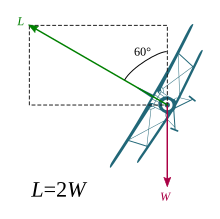G Force
The g force g is a measure of acceleration, treated in the general language as a force, although strictly speaking they are not the same physical magnitudes. It is based on the acceleration that the Earth's gravity would produce on any object. An acceleration of 1 g is generally considered to be equal to standard gravity, which is 9.80665 meters per second squared (m/s²).
It is written with a lowercase g, to differentiate it from the universal gravitational constant, which is a capital G. It is in italics, unlike the gram symbol, which is in the round.
The g force for an object is 0 g in any gravity-free environment, such as that experienced inside a spaceship or living space in free fall or on a satellite orbiting the Earth, and 1 g to any stationary object on the Earth's surface at sea level. On the other hand, g forces can be greater than 1, as in a roller coaster, centrifuge, or rocket.
The g forces are measured using an accelerometer.
Origin of these forces
Acceleration is a phenomenon familiar to anyone who has ever gotten into a car, experienced at every change in direction and speed from reference point. When some of these change, lateral (side to side) and longitudinal (front to back) changes may be felt.
Acceleration and the g force can be expressed in more familiar terms: An acceleration of 1g is the change in velocity of approximately 35 km/h or 9.72m /s (22 mph), in the span of 1 second. A high performance car can brake (slow down) at about 1g. This means that a car traveling at 105 km/h (66 mph) and braking in 1 second will experience a force of 3'g'.
Acceleration and forces
In 1687 Newton wrote his well-known Newton's Laws. In his second law, the law of acceleration, Newton raised an equation that reduced is written as F = m • a. This formula states that the force (F) acting on a body is equal to the mass (m) multiplied by the acceleration (a).
In Newton's third law, the law of opposite forces, it says:
All forces occur in a couple, and each of those forces is equal to the other, only in the opposite sense.
For Newton (and for all of us), his third law determined that gravity acting downward was not the only force acting to keep your hands down. Simultaneously, to raise your hands you must apply a greater force to it in the opposite direction, that is, upwards. When you throw a rock toward the ground, there are no forces acting in the opposite direction, so it will accelerate. This is in accordance with Newton's first law: the law of inertia.
Equation for g-force
To calculate the force acting on a body of mass m, in a gravitational field of acceleration of gravity g, according to Newton's second law:
- F=m⋅ ⋅ g{displaystyle mathbf {F} =mcdot mathbf {g} }
Where if the mass is expressed in kg, and the acceleration g in m/s², the force F will be obtained in newtons. The force: F, being a vector magnitude, has the same direction and meaning as the acceleration G.
Human tolerance
Human tolerance depends on the magnitude of the g-force, duration, direction, location applied, and body posture.
The human body is flexible and deformable (law of matter), particularly light tissues. A big blow to the face could go into the hundreds of g's, but it wouldn't do any real damage; 16 g for a minute can certainly be deadly. When vibration is involved, relatively low g-forces can be seriously damaging if they are at the resonant frequency of organs and tissues.
To some degree, tolerance to g-forces can be trainable, with considerable variation between individual resistances. Some diseases, such as cardiovascular problems, reduce tolerance to g-force.
Airplanes, in general, exert a large g-force on the axis associated with going up and down or taking off and landing. This causes a large variation in blood pressure; This can be seen in a fighter or stunt plane, as the pilots are exposed to large changes in gravity.
In airplanes, g-forces are usually directed toward the feet, causing less blood to reach the brain; mainly causing vision and brain problems. It also causes the almost immobility of the extremities, since they must support almost 13 times their weight. As g-forces increase, fainting or blackout can occur from lack of blood supply to the brain.
Recent experiments show that people without any kind of training can withstand 17 g forwards, (compared to the maximum 12 g backward force) for many minutes without losing consciousness or ending up with apparent damage.
Absorption capacity of mechanical watches 5000–7500 G.
- Ralf Schumacher in Indianapolis suffered a brutal accident, from which he left without serious problems, but with a peak of 72 g.
- On a roller coaster trip there are rapid changes between positive g (often reached over 4 g) and negative (over -1 g), which produces the typical feeling that attracts attention to people and makes these attractions like so much.
- Kenny Bräck suffered an accident with a peak of 214 g in the Indy Car category in 2003, Texas. This caused him the fracture of his stern and femur, as well as the dislocation of the ankle and a compression fracture in a vertebrae, it took him 18 months to recover, then make a quick spin in Indianapolis 366 km/h.
Note: the voluntary world record that a human has withstood in g-force is 82.6 g for just 0.04 seconds.
Contenido relacionado
Connection (mathematics)
Gerolamo Cardano
Generalized orthogonal Lie algebra



